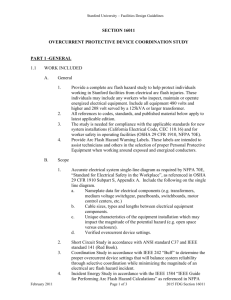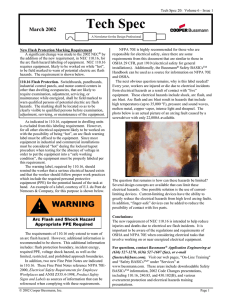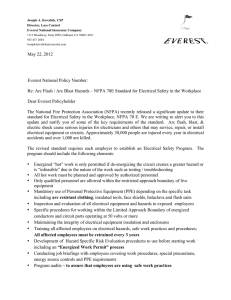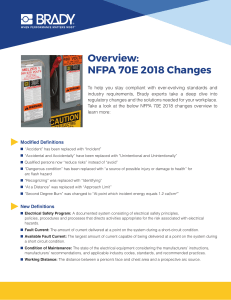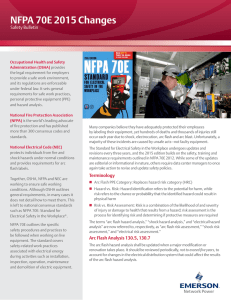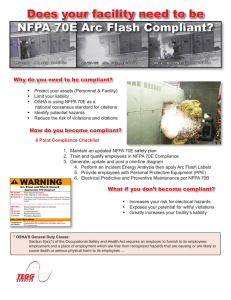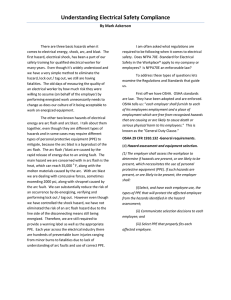Arc Flash, know your risk…
advertisement
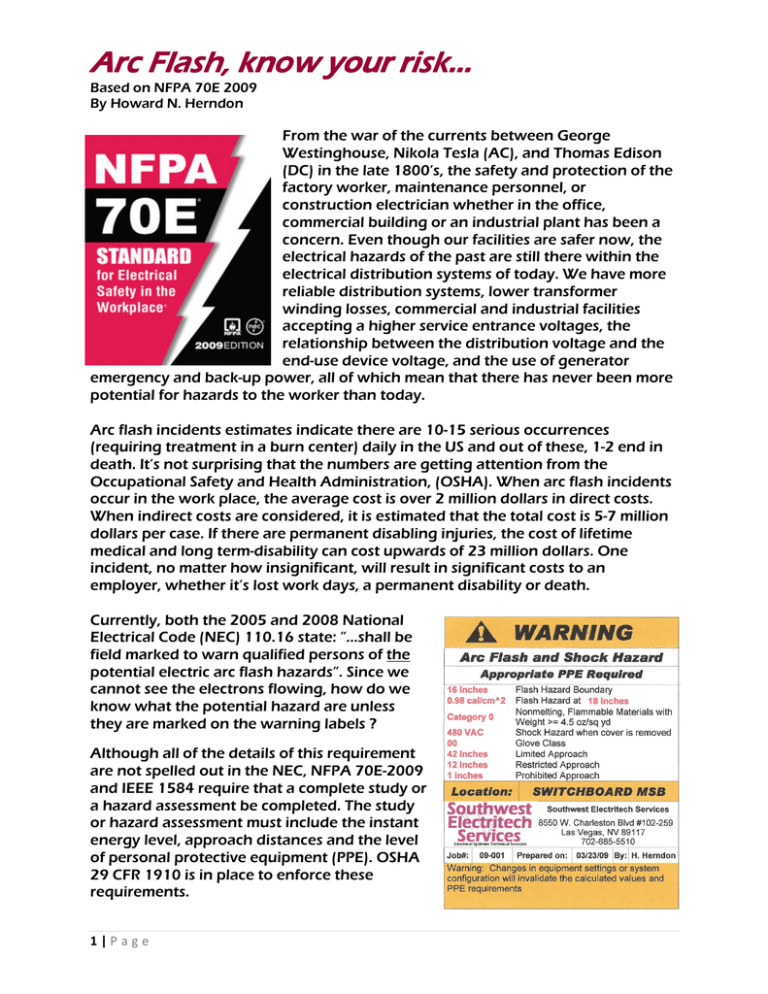
Arc Flash, know your risk… Based on NFPA 70E 2009 By Howard N. Herndon From the war of the currents between George Westinghouse, Nikola Tesla (AC), and Thomas Edison (DC) in the late 1800’s, the safety and protection of the factory worker, maintenance personnel, or construction electrician whether in the office, commercial building or an industrial plant has been a concern. Even though our facilities are safer now, the electrical hazards of the past are still there within the electrical distribution systems of today. We have more reliable distribution systems, lower transformer winding losses, commercial and industrial facilities accepting a higher service entrance voltages, the relationship between the distribution voltage and the end-use device voltage, and the use of generator emergency and back-up power, all of which mean that there has never been more potential for hazards to the worker than today. Arc flash incidents estimates indicate there are 10-15 serious occurrences (requiring treatment in a burn center) daily in the US and out of these, 1-2 end in death. It’s not surprising that the numbers are getting attention from the Occupational Safety and Health Administration, (OSHA). When arc flash incidents occur in the work place, the average cost is over 2 million dollars in direct costs. When indirect costs are considered, it is estimated that the total cost is 5-7 million dollars per case. If there are permanent disabling injuries, the cost of lifetime medical and long term-disability can cost upwards of 23 million dollars. One incident, no matter how insignificant, will result in significant costs to an employer, whether it’s lost work days, a permanent disability or death. Currently, both the 2005 and 2008 National Electrical Code (NEC) 110.16 state: ”…shall be field marked to warn qualified persons of the potential electric arc flash hazards”. Since we cannot see the electrons flowing, how do we know what the potential hazard are unless they are marked on the warning labels ? Although all of the details of this requirement are not spelled out in the NEC, NFPA 70E-2009 and IEEE 1584 require that a complete study or a hazard assessment be completed. The study or hazard assessment must include the instant energy level, approach distances and the level of personal protective equipment (PPE). OSHA 29 CFR 1910 is in place to enforce these requirements. 1|Page The Arc-Flash hazard is not just voltage, amperage, and the available fault current but, also the overcurrent device upstream and how quickly it operates. So finding this potential is not an easy calculation and can’t be found by just looking at a chart. Many authorities having jurisdiction (AHJ’s) are reluctant to enforce the actual requirements of NFPA 70E because they show up in the NEC as a fine print note (FPN). Although an AHJ can recommend that the requirements be implemented, ultimately it is the responsibility of the employer and/or the facility owner to insure that the requirements are met. In a legal situation, this responsibility could potentially be extended to the electrical engineer and installing contractor on the project, as well. If a facility utilizes an electrical contractor for any construction or modifications, the responsibility for safety still comes back to the employer or facility owner. Article 110.5 of NFPA 70E requires the host employers inform contractors of known hazards covered by NFPA 70E relating to the work to be done. The contract employer shall ensure that each employee working in their facility is instructed about the potential hazards. Training requirements, audits, retraining and written emergency procedures are also a big part of the NFPA 70E requirements. Each employee, whether a facility employee or a contractor employee, is required to be trained in the appropriate procedures, be made aware of proper PPE equipment selection for the hazard and receive ongoing training. Emergency procedures are also required to be in writing and training given to each employee, including cardiopulmonary resuscitation (CPR). The training shall be certified annually by the employer. Besides all of the above, NFPA 70E Article 200 requires maintaining and testing of the electrical equipment. As part of the electrical distribution system, Article 205.3 states “Overcurrent protective devices shall be maintained in accordance with the manufactures instructions and industry standards.” A regular maintenance plan and procedure is a critical part of the requirements. This requirement as spelled out by the manufacturer and in NFPA70B, this not only insures that the equipment is operating in a safe condition but also lessens the likelihood that an overcurrent device would not operate properly when required. The importance of maintaining and testing electrical equipment is illustrated in an IEEE study that investigated circuit breakers. This study found that fixed mounted molded case circuit breakers had a failure rate of 77% over the life of the equipment. This failure rate included: not opening when required, opening when it should not have opened, mechanical failures and defective components. Inadequate maintenance is a major contribution to this failure rate, probably due in large part to the thought, “If the lights are on, everything is working fine !” 2|Page As you can see from the above, the requirements are not simple and require the expertise of those who understand the standards and real-life practices. Here is a recap of the steps to bring your facility into compliance: 1. Site Hazard Analysis 2. Collection of Data 3. Testing and Maintenance of electrical distribution equipment 4. Short Circuit and Coordination Study 5. Arc Flash Study 6. Installation of Arc Flash Labels 7. Purchase of appropriate PPE 8. Training on use of PPE and all test equipment 9. Training on emergency procedure requirements including First Aid and CPR 10.Audit procedures, retrain, and maintain Obviously, the best way to prevent the arc flash hazard is for equipment to be totally de-energized when any type of servicing is done. Some of the common tasks that are done on energized equipment. • Using test equipment such as meters to check for troubleshooting, checking voltage, amperage and phase rotation • Removing or opening of panel covers, doors and dead fronts for inspections, repairs or trouble shooting • Opening and closing overcurrent devices • Replacing fuses • Operating breakers or fused switches with the cover off or doors open • Racking breakers in and out • Installing breakers or fused switches in energized equipment • Pulling wire into energized equipment When and if equipment cannot be totally de-energized, a hazard assessment must be performed, a written method of procedure (MOP) must be developed, and all employees must be familiar with the appropriate steps. We must insure that workers are trained on the appropriate use of PPE, testing equipment and emergency procedures to follow. This will provide as much protection as possible from the devastating effects of an arc flash occurrence. This information is not intended to be a complete guideline, but to bring out the key points in protecting employees from arc flash hazards. This article was written by Howard N. Herndon, Principle of Southwest Electritech Services. If you would like further information on Arc-Flash and the related requirements, Howard can be contacted at howard@sweservices.com or at (702) 685-5510 Copyright 2009 3|Page Southwest Electritech Services is an independent electrical technical and testing services company servicing Nevada, Arizona, Utah and California. We offer a broad range of electrical technical and testing services to promote the safe, reliable and efficient operation of your electrical distribution system. Through these services, we can provide strategic advantages to your projects, facility or clients. A key component in the safety of your electrical distribution system is the Short-Circuit, Coordination Studies and Arc Flash Hazard Analysis that we provide. We also provide site surveys as well as training and maintenance programs to insure your compliance with the National Electric Code (NEC), OSHA and NFPA 70E 2009 requirements. From start-up and commissioning of the newly installed equipment, to acceptance and maintenance testing, we can design and establish a program to maximize the uptime and safety of your individual electrical system. We can recommend a testing schedule for each component and the specific tests to be performed. When our work is complete, you will receive a comprehensive report with detail on the test performed, servicing and evaluation data: as well as a prioritized action plan to keep your electrical system operating in a safe condition. • • • • • • • • • • • • Start-Up and Commissioning Power Quality Monitoring Load Monitoring and Analysis Infrared and Thermography Switchboard and Switchgear Testing Circuit Breaker Testing Ground-Fault System Testing Transformer Testing Transformer Oil Sampling Grounding Resistance Testing Design Reviews Code Compliance Review We would sincerely appreciate the opportunity to be of service to you. Please do not hesitate to contact us if you have any questions 4|Page

